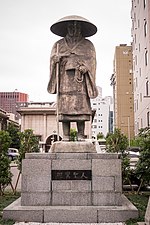Chūō, Tokyo

Chūō (中央区, Chūō-ku) is a special ward that forms part of the heart of Tokyo, Japan. The ward refers to itself in English as Chūō City. It was formed in 1947 as a merger of Kyobashi and Nihonbashi wards following Tokyo City's transformation into Tokyo Metropolis. Chūō-ku, as a combination of Kyobashi and Nihonbashi, is the core of Shitamachi, the original downtown center of Edo-Tokyo. Literally meaning "Central Ward", it is historically the main commercial center of Tokyo, although Shinjuku has risen to challenge it since the end of World War II. The most famous district in Chūō is Ginza, built on the site of a former silver mint from which it takes its name. The gold mint, or Kinza (金座), formerly occupied the site of the present-day Bank of Japan headquarters building, also in Chūō. As of May 1, 2015, the ward has an estimated resident population of 141,454, and a population density of 13,850 persons per km2. The total area is 10.21 km2. However, because of the concentration of businesses, offices and retail space, the daytime population swells to an estimated 650,000.
Excerpt from the Wikipedia article Chūō, Tokyo (License: CC BY-SA 3.0, Authors, Images).Chūō, Tokyo
Circle 1, Chuo
Geographical coordinates (GPS) Address Nearby Places Show on map
Geographical coordinates (GPS)
| Latitude | Longitude |
|---|---|
| N 35.666666666667 ° | E 139.76666666667 ° |
Address
銀座
Circle 1
104-0041 Chuo
Japan
Open on Google Maps









